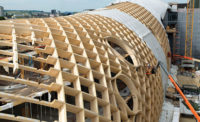On the surface at least, it is hard to imagine a more incongruous combination of architect and client: the London-based John Pawson, known for his starkly Minimal and elegant temples to material culture, and a community of Cistercian monks whose lives revolve around prayer, study, and physical labor. But just such an odd couple has created a luminous monastery in a remote corner of Bohemia, the first built in the Czech Republic since the 1989 Velvet Revolution ended four decades of religious suppression.
The monastery, Our Lady of Novy Dvur, was founded by a group of mostly Czech Cistercians relocating from Sept-Fons Abbey in central France. Pawson won the commission in 1999 after Sept-Fons’s abbot saw photographs of the architect’s New York City Calvin Klein boutique. Though the store’s program and consumerist mission could not differ more from a monastery’s, the abbot saw in its Minimalism a spirit akin to traditional Cistercian buildings. As Father M. Samuel, superior of Novy Dvur recalls, “His work seemed well adapted to a monastic architecture.”
Novy Dvur sits on a wooded, 100-acre site about 30 miles northwest of Pilsen. Here, on a slope, stood an abandoned 18th-century manor house that Pawson, with the Czech firm Atelier Soukup, restored and incorporated into the design. In place of several dilapidated agriculture buildings surrounding a court shared by the house, the team created three new wings that recall the character of the original structures.
The resulting 60,000-square-foot complex includes a church, dormitory, refectory, infirmary, and manuscript room—everything this religious community needs for a self-sufficient, structured routine that begins at 3:15 a.m. and includes prayer seven times a day. Now 20 monks live at Novy Dvur, but it is designed for an eventual group of about three dozen brothers. The architecture serving their ascetic life is accordingly spare, characterized by smooth, white plaster; concrete; glass; wood; and stone. As Pawson puts it, “An absence of visual and functional distraction supports the goal of monastic life: concentration on God.”
Reducing the architecture to essentials, he has seemingly questioned the necessity of every element, even structure. In the glass-enclosed cloister, a barrel-vaulted ceiling cantilevers toward the grassy inner court. With no columns at the perimeter, an interior bench becomes a rainwater canal on the exterior, opening the walkway visually to the court—a modern interpretation of the traditionally more contained (or “cloistered”) space.
PeopleOwner: Architect: Executive Architect: Collaborating Architect: Landscape Architect: Engineers: RAVAL v.o.s., Pilsen Electrical Engineer: Consultants: ETNA spol. s.r.o., Prague Acoustic Consultants: Akustika Praha s.r.o., Prague Project Manager: General contractor: Starkon CZ a.s., Jihlava Heating: Ventilation: Water/Drainage: IT Consultant: Organ Design and Fabrication: Photographers: CAD system, project management, or other software used: AutoCAD |
ProductsExterior Cladding: Roofing: Slate Roofing: Zinc Roofing: Cloister Floor: Canal/Bench and Exterior Window Frames: Door Handles: FSB
Church Skylight: Floor: Furniture: Interior Finishes: Exterior Walls: Lime render Interior Walls: Windows: Cloister: New: Cabinetry/Millwork: Pliumbing:
|














